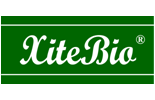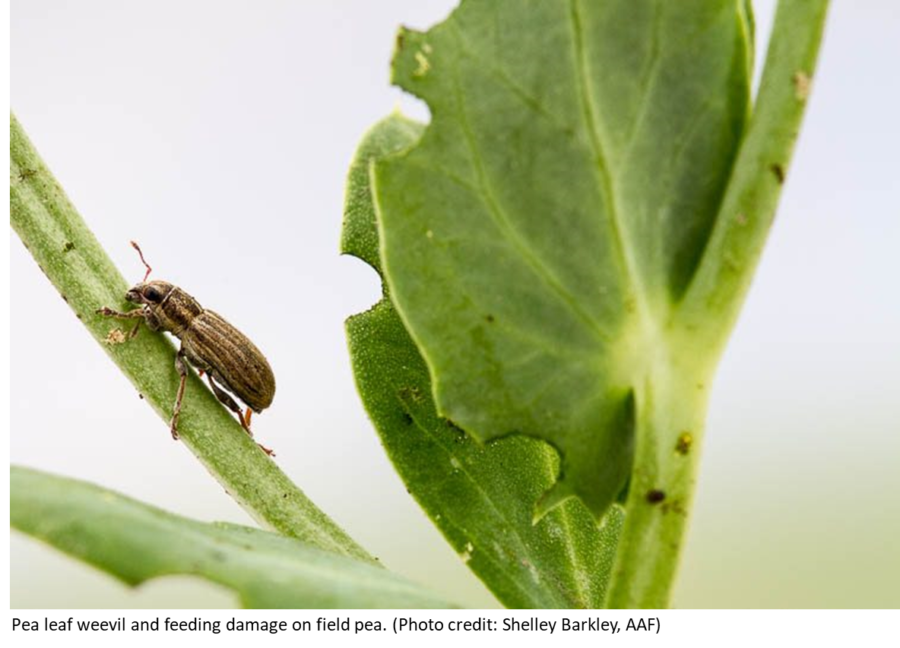One of the major pests North American pulse farmers will be dealing with this year is Pea Leaf Weevils. They can have a huge effect on nitrogen fixation, reduce yields and erase the effects of applied fertilizers and inoculants on your pea and faba bean crops. So what are Pea Leaf Weevils? And how do they affect nitrogen fixation in your crops?
Pea Leaf Weevils (Sitona lineatus) are present in virtually all pea producing regions in the world and have become a major economic pest in North American pulse crop regions such as Alberta, Saskatchewan and Montana (1).
Pea Leaf Weevil adults emerge from the soil in early spring and begin feeding on the foliage of pulse and legume crops. The way in which they feed leaves U-shaped notches on foliage, which is a good indicator of their presence (1). Adult weevils lay their eggs on the surface of the soil surrounding pea and faba bean plants. When the eggs hatch, the larvae burrow down into the soil and seek out their primary food source: nitrogen rich root nodules (2). When it comes to affecting your yields, larval feeding and loss of nodules is the main contributor, as defoliation by adult weevils has shown to be far less detrimental compared to the damage their larvae do to root systems (2). The feeding of larvae on nodules can severely limit the nitrogen fixation potential of a plant and cause a huge effect on plant health and yield, with a population of 100 eggs per plant reducing yield by up to 27% (1).
When checking your fields for the presence of weevils, it is recommended to scout your plants at the 2-4 node stage of development, as adults will start feeding around this time. If 30% or more of your plants show signs of notching due to weevil feeding, then you may have an infestation large enough to affect your yield (3).
Both foliar applied insecticides and seed-treatment insecticides exist to deal with Pea Leaf Weevil populations, but foliar applied insecticides have shown to be less effective at controlling larva populations than the-seed treatments, even when a reduction in foliage loss and adult weevil population is seen (4). Alberta Pulse Growers Commission recommends seed treatment insecticides as the best way to target larval populations and limit the damage they can cause to your crop (3). When choosing an insecticide, make sure it is compatible with any inoculants you may be using at the same time. When choosing an insecticide, check compatibility with any inoculants or biologicals you are using with the inoculant/biological manufacturers’ recommendations.
References
1) Reddy, G. V. P., Shrestha, G., Miller, D. A., & Oehlschlager, A. C. (2018). Pheromone-trap monitoring system for pea leaf weevil, Sitona lineatus: Effects of trap type, lure type and trap placement within fields. Insects, 9(3). https://doi.org/10.3390/insects9030075
2) Cárcamo, H. A., Herle, C. E., Lupwayi, N. Z., & Weintraub, P. (2015). Sitona lineatus (Coleoptera: Curculionidae) Larval Feeding on Pisum sativum L. Affects Soil and Plant Nitrogen. Journal of Insect Science, 15(1). https://doi.org/10.1093/jisesa/iev055
3) https://albertapulse.com/2020/05/be-prepared-for-when-pea-leaf-weevil-attacks/
4) Cárcamo, H., Herle, C., & Hervet, V. (2012). Greenhouse Studies of Thiamethoxam Effects on Pea Leaf Weevil, Sitona lineatus . Journal of Insect Science, 12(151), 1–12. https://doi.org/10.1673/031.012.15101


